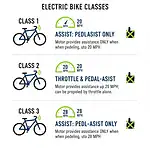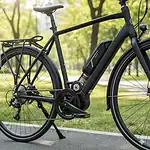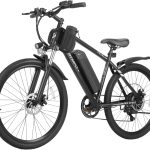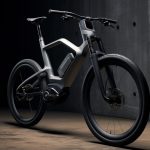Why Battery Care Matters
An e-bike’s battery is its lifeblood. It determines how far you can ride, how much assist you feel, and how reliable your bike stays over time.
And while motors grab the spotlight, the battery is usually the most expensive component—often a third of the bike’s total cost.
Good news: with just a few smart habits, you can easily add 1–2 extra years to your battery’s lifespan.
In this guide, we’ll break down how to charge, store, and handle your e-bike battery safely—using real manufacturer data and energy-efficiency best practices.

⚡ Understanding E-Bike Batteries
Most modern e-bikes use lithium-ion (Li-ion) batteries—the same technology found in electric cars and laptops, only scaled for bike use.
They’re light, powerful, and rechargeable thousands of times if maintained properly.
🔋 Key Terms You’ll See
| Term | Meaning | Typical Value |
|---|---|---|
| Voltage (V) | Electrical pressure; affects power output | 36 V, 48 V, or 52 V |
| Capacity (Ah) | Current available | 10–20 Ah |
| Energy (Wh) | V × Ah; overall stored energy | 400–750 Wh |
| BMS | Battery Management System | Prevents over-charge/discharge |
A higher watt-hour (Wh) rating equals longer range, but weight and cost rise too.
Understanding these numbers helps you make smart charging decisions later.
🧠 How Charging Actually Works
When you plug in your charger, the battery’s BMS controls the flow of current.
Charging occurs in two stages:
- Constant Current (CC): Fast fill—charges to about 80 %.
- Constant Voltage (CV): Slower topping-off—brings it to 100 %.
That second stage generates more heat and stress, so you don’t always need a full charge unless you’re planning a long ride.
💡 Quick Tip:
For daily commuting, charging to 80–90 % gives the best balance between range and longevity.
🔋 Optimal Charging Habits
✅ Do
- Use only the manufacturer’s charger—different chargers may deliver unsafe voltage.
- Plug the charger into the wall first, then into the bike.
- Charge at room temperature (10–25 °C / 50–77 °F).
- Unplug when full; most chargers have an indicator light.
❌ Avoid
- Leaving it plugged in for days.
- Charging under direct sunlight or freezing temperatures.
- Using extension cords outdoors unless weather-rated.
🕒 How Often to Charge
It’s a myth that you should always run the battery to zero.
Li-ion cells prefer partial discharges. Try to keep charge levels between 30 % and 80 % most of the time.
Scenario Examples:
- Daily 10-mile commute → charge every 2–3 rides.
- Long weekend ride → full charge night before.
- Winter storage → top to 60 % every 2 months.
Every full charge-discharge cycle (0 → 100 %) counts as one cycle.
Partial recharges count fractionally, which extends total cycle life.
🌡️ Temperature: The Silent Battery Killer
Both extreme heat and cold shorten lifespan.
Chemical reactions inside Li-ion cells slow in cold weather and accelerate in heat—both harmful if prolonged.
| Condition | Effect | Prevention |
|---|---|---|
| < 0 °C / 32 °F | Reduced range | Warm indoors before charging |
| > 35 °C / 95 °F | Permanent capacity loss | Avoid direct sunlight, car trunks |
| Humid storage | Corrosion risk | Use dry, ventilated room |
If you commute in winter, expect up to 20 % less range—it’s normal.
Just recharge indoors once the battery returns to room temp.
🏠 Proper Storage Practices
When you’re not riding for weeks or months (winter break, travel, etc.), store the battery correctly:
- Charge to ~60 %.
Prevents deep discharge and stress. - Turn off or disconnect the bike’s main switch.
- Keep indoors at 10–20 °C (50–68 °F).
- Avoid metal contact with terminals—use a soft cover or case.
- Recharge every 2–3 months if idle.
⚠️ Never store a fully depleted battery—it may fall below safe voltage and become unrecoverable.
🧰 Cleaning & Handling Tips
- Remove the battery before washing your e-bike.
- Use a damp cloth only; never a pressure washer.
- Clean connectors with contact spray if corroded.
- Check for cracks or swollen cells—signs of damage.
If your battery was dropped or shows swelling, stop using it immediately and contact your dealer or recycler.
⚙️ Charging Accessories That Help
| Accessory | Why It Helps |
|---|---|
| Smart Charger | Lets you stop at 80 % or 90 %. |
| Fireproof Charging Bag | Containment for safety (common with Li-ion devices). |
| Wall Mount / Dock | Keeps airflow around battery during charge. |
| Inline Timer Plug | Automatically shuts off after set hours. |
Manufacturers like Bosch, Shimano, and Rad Power Bikes often recommend timers for overnight charging convenience.
🔋 Signs Your Battery Needs Service
Over time, all batteries lose capacity. You’ll notice:
- Range dropping faster than usual.
- Uneven power delivery or sudden cut-offs.
- Charger LED not switching to green.
- Battery getting unusually warm.
If any occur, test with a multimeter or visit an authorized service center.
🧪 How to Test Battery Health
Most systems (Bosch, Yamaha, Shimano STEPS) log charge cycles and voltage.
You can also estimate manually:
- Fully charge battery.
- Ride a known route (flat, same assist).
- Compare miles achieved to previous data.
If range drops > 30 % from new, it’s time for diagnostics.
Some shops offer capacity testing for around $30–50.
🔌 Common Charging Mistakes
⚠️ 1. Overcharging
Modern BMS stops flow automatically, but leaving plugged in 24/7 heats cells over time.
Better: unplug within a few hours of full charge.
⚠️ 2. Deep Discharging
Riding until power cuts completely stresses cells; always recharge before 10 % level.
⚠️ 3. Wrong Charger
A mismatched charger (wrong voltage/amp rating) can permanently damage the pack.
⚠️ 4. Outdoor Overnight Charging
Even under a porch, humidity and temperature swings shorten life—charge indoors whenever possible.
🧩 Maximizing Range on Every Ride
Range doesn’t depend only on battery size—it’s also about how efficiently you ride.
Range Boost Checklist:
- Use Eco or Tour mode when terrain allows.
- Keep tire pressure optimal (check weekly).
- Avoid constant full-power bursts.
- Shift gears before steep climbs.
- Keep drivetrain clean—dirt increases resistance.
- Use regenerative braking if available (rare, but helps).
Example: Switching from Turbo to Eco mode can extend range by 30–40 % on flat commutes.
⚖️ Safety & Disposal
Never throw an e-bike battery in household trash.
Lithium-ion packs are considered hazardous material under EPA regulations.
- Recycle: Many bike shops participate in Call2Recycle.org drop-off programs.
- Transport: Use insulated cases; avoid punctures or exposure to metal tools.
- Replacement: Always buy OEM or certified compatible batteries—avoid unbranded imports.
🔋 Frequently Asked Battery Questions (Snippet Section)
💬 How long do e-bike batteries last?
Average lifespan: 500–1,000 full charge cycles, or 3–5 years for most riders.
Light users may see 7 years with proper care.
💬 Should I fully charge every time?
No. Stop at 80–90 % for daily use unless you need maximum range.
💬 Is it safe to charge overnight?
Generally yes, with the correct charger and in a safe, dry place.
Avoid covering the battery or charging near flammable items.
🌱 Environmental Benefits of Proper Care
Each battery lasts longer when properly maintained—reducing electronic waste.
According to Energy.gov, improving average battery life from 3 to 5 years can reduce e-bike battery waste by over 35 % nationwide.
Recycling also recovers nickel, cobalt, and lithium, lowering mining impact and keeping toxic materials out of landfills.
🧭 Next Steps
Now that you understand how to care for your e-bike battery, keep learning with these helpful resources:
🤔 FAQs
Charge whenever it drops below 40–50 %. Frequent small top-ups are healthier than deep discharges.
Yes, if temperatures stay moderate (50–77 °F) and it’s kept dry. Avoid hot attics or freezing sheds.
Take it to a certified recycling point—never put it in household trash. Programs like Call2Recycle handle it free of charge.






